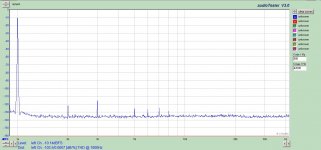the 'russian doll' version of the capacitor 😉
its an old photo. been around the net for years.
its an old photo. been around the net for years.
A few days ago I finally got around to swapping my stock output DCX for a minidsp nanodigi feeding a cheap audiophonics/teradak ess9023 i2s dac board.
I didn't do a proper a/b test, but with roughly similar EQ curves, the nanodigi ess9023 combo sounds much better to me. There appears to be more HF detail and just overall life to the music. Acoustic guitars and percussion sounds much more lifelike. I'd be interested to see if its the output circuitry in the stock DCX that is holding it back....
I didn't do a proper a/b test, but with roughly similar EQ curves, the nanodigi ess9023 combo sounds much better to me. There appears to be more HF detail and just overall life to the music. Acoustic guitars and percussion sounds much more lifelike. I'd be interested to see if its the output circuitry in the stock DCX that is holding it back....
One very simple test would be to put the minidsp in one channel and the the DCX in the other channel or treat them as separate sources or depends on your switching flexibility. Pretty simple. Then you might be able to tell (or not tell) if there's more air between the instruments.A few days ago I finally got around to swapping my stock output DCX for a minidsp nanodigi feeding a cheap audiophonics/teradak ess9023 i2s dac board.
I didn't do a proper a/b test, but with roughly similar EQ curves, the nanodigi ess9023 combo sounds much better to me. There appears to be more HF detail and just overall life to the music. Acoustic guitars and percussion sounds much more lifelike. I'd be interested to see if its the output circuitry in the stock DCX that is holding it back....
Naturally, in doing a test of this sort, you need to be absolutely certain there are no differences what so ever in loudness or EQ (in which case, testing flat would be easiest). Even one dB extra loudness would give people with wonderfully sensitive ears the impression of greater liveliness (or whatever) to the louder source.
As soon as you say "ummm, I'm going to listen real carefully to this new feature" the sound gets better. Especially if you made the change yourself.
Ben
Last edited:
....
As soon as you say "ummm, I'm going to listen real carefully to this new feature" the sound gets better. Especially if you made the change yourself.
Ben
I agree that non a/b testing is pretty unreliable. I will say though that with the same EQ in the nanodigi and a different Burr Brown DAC I didn't enjoy listening to it at all, and that I wasn't expecting much from this China $14 PCB. I had heard good things about the ess9023 though, so that may have affected my perception.
I am though very much enjoying not having the CS8420 bug rearing its head regularly anymore though!
Cheers.
I was very dissappointed in the treble "lack of sparkle" compared to the passive I was trying to emulate.
I later read that the DCX2496 sometimes defaults to some error setup that removes treble.
It is curable with a hardware modification that always boots up with the correct treble response. I have not carried out the modification.
I found the start of the treble response discussion.
http://www.diyaudio.com/forums/digi...er-dcx2496-digital-x-over-59.html#post1308763
I later read that the DCX2496 sometimes defaults to some error setup that removes treble.
It is curable with a hardware modification that always boots up with the correct treble response. I have not carried out the modification.
I found the start of the treble response discussion.
http://www.diyaudio.com/forums/digi...er-dcx2496-digital-x-over-59.html#post1308763
Last edited:
I was very dissappointed in the treble "lack of sparkle" compared to the passive I was trying to emulate.....
Cheers Andrew.
I got very familiar with this bug over the years, my unit was terrible for it. I wouldn't describe it as simply a lack of sparkle though - it was much worse than that and very obviously(to me anyway) a fault condition when it occurred. If you measured the output while in this bug state you could see a deep wide notch around 4khz(iirc).
When working properly the DCX sounded good, but this new combo to me is a decent improvement.
The CS8420 bug would only affect people using the DCX2496's input A in AES/SPDIF mode. If you're using its inputs A and B in analog mode then the CS8420 isn't used at all. Just thought I'd chime in, in case anyone is unaware.
The CS8420 bug would only affect people using the DCX2496's input A in AES/SPDIF mode. If you're using its inputs A and B in analog mode then the CS8420 isn't used at all. Just thought I'd chime in, in case anyone is unaware.
Yes worth pointing out, cheers. I've never tried the analog inputs on my DCX actually....
RightMark Audio Analyzer
Hallo,
I wish you a nice day.
This fibre o DCX2496 is 12 years old, and so it is undeniable to wonder, that manny pictures and attachments absent.
Have anyone of you results (digital IN => analog OUT) of measurement DCX2496 with
RMAA (RightMark Audio Analyzer), please?
Thanks
Hallo,
I wish you a nice day.
This fibre o DCX2496 is 12 years old, and so it is undeniable to wonder, that manny pictures and attachments absent.
Have anyone of you results (digital IN => analog OUT) of measurement DCX2496 with
RMAA (RightMark Audio Analyzer), please?
Thanks
Right Mark won't tell you what you want to know. Better just to look at a spectrum via FFT. I posted that a few years ago. I'm sure others have too.
My files are a mess, I didn't document "as found" conditions, but this is what I get after a number of mods. Digital input using SPDIF, output stage consists of Jensen output transformer directly connected to DAC pins. Stock power supply. Full scale output on DCX (just before clipping).
Thought I had some 10 kHz measurements, but not finding them. Could re-take I suppose.
Quality xfmr output is the way to go IMO.
Thought I had some 10 kHz measurements, but not finding them. Could re-take I suppose.
Quality xfmr output is the way to go IMO.
Attachments
I had some spare time on my holiday so I've got some work done on my DCX . I finaly installed the WaveIO permanently, also the Selectronic clock. The shunts (four of them in the end) go above the DCX chassis, also the new transformer and rectifier/filter.
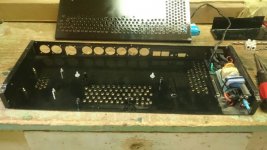
Swiss cheese. 40W of dissipation have to go out in the end. On the right is a mains filter.
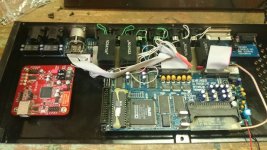
"Lower floor", the original chassis. Left is the WaveIO usb interface, in the back coupling capacitors for direct out mod. Note the Neutrik USB chassis connector.
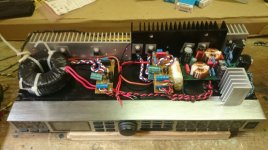
This is the business end. Still one shunt to complete. 100VA transformer and 3A contignuos consumption. The heatsinks are on the hot side when boxed.
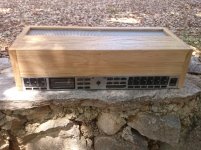
The new chassis

Swiss cheese. 40W of dissipation have to go out in the end. On the right is a mains filter.

"Lower floor", the original chassis. Left is the WaveIO usb interface, in the back coupling capacitors for direct out mod. Note the Neutrik USB chassis connector.

This is the business end. Still one shunt to complete. 100VA transformer and 3A contignuos consumption. The heatsinks are on the hot side when boxed.

The new chassis
I patiently await seeing the double-blind test. Any plans?
B.
Can we see the before and after measurements.
Ben
Ben, you keep asking for measurments and blind tests but remain unsatisfied with the answers, disrespecting our efforts to give you something of a value.
Now, I ask you for help. I would like to do the measurments, but don't know how to produce meaningful results.
What measuring equipment would you like me to use? I have an M-audio FastTrak Pro usb interface, is that good enough?
What excact measurments should I make? How to set up the tests?
Thanks,
Marko
What excact measurments should I make? How to set up the tests?
I guess a lot depends on what specific improvements you feel you have achieved. Just measuring the output signal with no input gives a decent idea about the SNR, and spectrum analysis of a single sine wave gives an idea of both harmonic and intermodulation distortion. For jitter, you just need to use a slightly more complicated input signal (the classical J-test).
My audio interface has the following specifications:
Instrument Inputs (A/D)
Input Impedance: greater than 220k Ohm, unbalanced
Maximum Input Level: From +22dBV @ min gain, pad on to -42dBV @ max gain no pad
SNR: -100dB, A-weighted
Dynamic Range: 100dB, A-weighted
THD+N: 0.005% (-86dB) @ -1dBFS, 1kHz
Frequency Response: 20Hz to 20kHz, +/- 0.1dB @ 48kHz sample rate
Pre-amp Gain: >40dB
Attenuation pad: -20dB pad
Is it good for taking the measurements? How can I verify that I'm measuring the SNR or harmonic distortion of the DCX and not of the interface's preamp or ADC?
Sent from my C6903 using Tapatalk
Instrument Inputs (A/D)
Input Impedance: greater than 220k Ohm, unbalanced
Maximum Input Level: From +22dBV @ min gain, pad on to -42dBV @ max gain no pad
SNR: -100dB, A-weighted
Dynamic Range: 100dB, A-weighted
THD+N: 0.005% (-86dB) @ -1dBFS, 1kHz
Frequency Response: 20Hz to 20kHz, +/- 0.1dB @ 48kHz sample rate
Pre-amp Gain: >40dB
Attenuation pad: -20dB pad
Is it good for taking the measurements? How can I verify that I'm measuring the SNR or harmonic distortion of the DCX and not of the interface's preamp or ADC?
Sent from my C6903 using Tapatalk
- Home
- Source & Line
- Digital Line Level
- Behringer DCX2496 digital X-over
